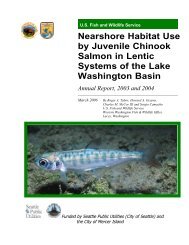- Page 1 and 2:
WaterComprehensivePlan
- Page 6 and 7:
ASSET MANAGEMENTR&R needs areregula
- Page 8 and 9: CONTENTSExecutive SummaryPageiiiCha
- Page 10 and 11: Chapter 12 - Financial Information
- Page 12 and 13: 10-1 Federal Drinking Water Quality
- Page 14 and 15: CHAPTER 1IntroductionUtilities Depa
- Page 16 and 17: Demand. The quantity of water obtai
- Page 18 and 19: EKCEast King CountyEKC-CWSP East Ki
- Page 20 and 21: CHAPTER 2Water Utility PoliciesThe
- Page 22 and 23: owner agrees to reimburse the City
- Page 24 and 25: Facility AbandonmentWhen the Utilit
- Page 26 and 27: Discussion:The Utility should syste
- Page 28 and 29: Discussion:It is Bellevue’s polic
- Page 30 and 31: Discussion:In 1982, Bellevue, along
- Page 32 and 33: Waterworks UtilityFinancial Policie
- Page 34: B. Self-sufficient FundingEach Util
- Page 40 and 41: B. Funding LevelsFunding for capita
- Page 44 and 45: D. Capital Facilities Renewal & Rep
- Page 46 and 47: overhead for developer extension pr
- Page 48 and 49: equired to balance the expenses. A
- Page 50 and 51: demonstrate that the hydrologic res
- Page 52: adopted to recover those costs dire
- Page 55 and 56: In 2004, the Financial Consulting S
- Page 57: Discussion:Providing reserves for e
- Page 61 and 62: Table 3-2Residential Population Pro
- Page 63 and 64: 2006CURRENT LAND USENE 8TH ST104TH
- Page 65 and 66: SERVICE AREAThe current Bellevue ci
- Page 67 and 68: Table 3-3Interties(Regional Supply
- Page 69 and 70: Bellevue and Kirkland are currently
- Page 71 and 72: Water District No. 22Water District
- Page 73 and 74: Utility Service Review ProceduresTh
- Page 75 and 76: CHAPTER 4Water RequirementsThe exis
- Page 77 and 78: This type of demand is relatively c
- Page 79 and 80: • Apparent Losses: Includes unaut
- Page 81 and 82: Existing DemandExisting water deman
- Page 83 and 84: The future build-out demand project
- Page 85 and 86: Table 4-4cBuildout Demand Projectio
- Page 88 and 89: Table 4-6Comparison of Eastside Com
- Page 90 and 91: pressure throughout the rest of the
- Page 92 and 93: Pressure ZonesPressure zones are de
- Page 94 and 95: CHAPTER 5Water ConservationThe City
- Page 96 and 97: identifies the main categories of a
- Page 98 and 99: Table 5-2Historical Conservation Me
- Page 100 and 101: Speakers BureauThis measure is defi
- Page 102 and 103: Bill Showing Consumption HistoryThi
- Page 104 and 105: schedules, and efficient irrigation
- Page 106 and 107: Seasonal Demand ManagementThis meas
- Page 108 and 109:
RowTable 5-5Conservation Savings Ac
- Page 110 and 111:
Figure 5-1Single Family Water Use P
- Page 112 and 113:
Since the post-conservation era beg
- Page 114 and 115:
statement about each measure is inc
- Page 116 and 117:
CHAPTER 6Existing SystemThis chapte
- Page 118 and 119:
KIRKLANDREDMONDLakeWashingtonWest B
- Page 123 and 124:
City of BellevueWater Pressure Zone
- Page 125 and 126:
Supply ConnectionNE 40th InletCherr
- Page 127 and 128:
appropriate, PRV records also inclu
- Page 129 and 130:
Table 6-5Pump StationsPage 1 of 2Na
- Page 131 and 132:
Table 6-6Storage FacilitiesPage 1 o
- Page 133 and 134:
HYDRAULIC OPERATIONSTables 6-7 thro
- Page 135 and 136:
ZonePrimary SupplyConnectionsReserv
- Page 137 and 138:
ASSET MANAGEMENT PROGRAM DEVELOPMEN
- Page 139 and 140:
total business risk exposure.Determ
- Page 141 and 142:
PIPELINE RENEWAL AND REPLACEMENTBel
- Page 143 and 144:
In 1999 Montgomery Watson completed
- Page 145 and 146:
CHAPTER 8System AnalysisThe purpose
- Page 147 and 148:
from Seattle’s Eastgate and SE 28
- Page 149 and 150:
year. When these small-diameter pip
- Page 151 and 152:
Fire Flow VolumeDefinitionWAC 246-2
- Page 153 and 154:
increase in demand anticipated due
- Page 155 and 156:
Table 8-1bSummary of Storage Evalua
- Page 157 and 158:
Storage Conclusions and Recommendat
- Page 159 and 160:
To evaluate required capacity for t
- Page 161:
CHAPTER 9Operations and Maintenance
- Page 166 and 167:
Table 9-1Engineering and Environmen
- Page 168 and 169:
Table 9-3Water Department Vehicles
- Page 170 and 171:
RECORDS AND DATA MANAGEMENTSystem O
- Page 172 and 173:
Pump Stations. Each pump station is
- Page 174 and 175:
CHAPTER 10Water QualityThis Chapter
- Page 176 and 177:
Bellevue is responsible for monitor
- Page 178 and 179:
Table 10-2Annual Average of Total T
- Page 180 and 181:
esponsible for collecting any repea
- Page 182 and 183:
While the CCR provides an annual
- Page 184 and 185:
• Very Small System Waiver - Syst
- Page 186 and 187:
CCL, which is comprised of 51 (nine
- Page 188 and 189:
• Aging infrastructure and corros
- Page 190 and 191:
SUMMARY OF MONITORING REQUIREMENTST
- Page 192 and 193:
. At the time the backflow preventi
- Page 194 and 195:
Element 8: The purveyor shall inclu
- Page 196 and 197:
separation of common water inlets/o
- Page 198 and 199:
Fire Hydrant ImprovementsThis progr
- Page 200 and 201:
PRIORITIZATION OF IMPROVEMENTSCapit
- Page 202 and 203:
CHAPTER 12Financial InformationThis
- Page 204 and 205:
TABLE 12-2City of BellevueWater Uti
- Page 206 and 207:
during periods of high expenditures
- Page 208 and 209:
Bonds issued by the "Waterworks Uti
- Page 210 and 211:
TABLE 12-5City of BellevueWaterwork
- Page 220:
APPENDIX BService Area and Adjacent
- Page 486 and 487:
APPENDIX DAdjacent Purveyor Review
- Page 488 and 489:
CopyCenterFrom: Thompson, Randall L
- Page 490 and 491:
CopyCenterFrom:Scott Thomasson [STH
- Page 492 and 493:
CopyCenterFrom:Bob Trimble [bob.tri
- Page 494 and 495:
Consistency w/SPU forecast for wate
- Page 496 and 497:
Provision of SDWA water quality rep
- Page 498 and 499:
• Federally-approved habitat cons
- Page 500:
APPENDIX EConsistency Statement Let
















